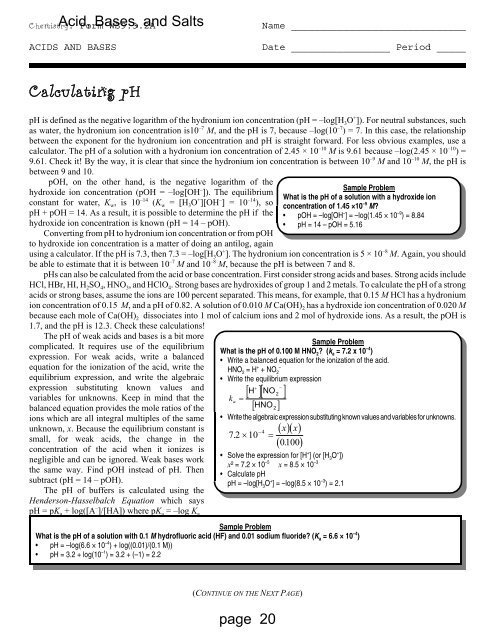Acid Base packet
Acid Base packet
Acid Base packet
Create successful ePaper yourself
Turn your PDF publications into a flip-book with our unique Google optimized e-Paper software.
<strong>Acid</strong>, <strong>Base</strong>s, and Salts<br />
Chemistry: Form WS9.3.2A Name ______________________________<br />
ACIDS AND BASES Date _________________ Period _____<br />
Calculating pH<br />
pH is defined as the negative logarithm of the hydronium ion concentration (pH = –log[H 3O + ]). For neutral substances, such<br />
as water, the hydronium ion concentration is10 –7 M, and the pH is 7, because –log(10 –7 ) = 7. In this case, the relationship<br />
between the exponent for the hydronium ion concentration and pH is straight forward. For less obvious examples, use a<br />
calculator. The pH of a solution with a hydronium ion concentration of 2.45 × 10 –10 M is 9.61 because –log(2.45 × 10 –10 ) =<br />
9.61. Check it! By the way, it is clear that since the hydronium ion concentration is between 10 –9 M and 10 –10 M, the pH is<br />
between 9 and 10.<br />
pOH, on the other hand, is the negative logarithm of the<br />
hydroxide ion concentration (pOH = –log[OH – ]). The equilibrium<br />
constant for water, K w, is 10 –14 (K w = [H 3O + ][OH – ] = 10 –14 ), so<br />
pH + pOH = 14. As a result, it is possible to determine the pH if the<br />
hydroxide ion concentration is known (pH = 14 – pOH).<br />
Converting from pH to hydronium ion concentration or from pOH<br />
to hydroxide ion concentration is a matter of doing an antilog, again<br />
using a calculator. If the pH is 7.3, then 7.3 = –log[H 3O + ]. The hydronium ion concentration is 5 × 10 –8 M. Again, you should<br />
be able to estimate that it is between 10 –7 M and 10 –8 M, because the pH is between 7 and 8.<br />
pHs can also be calculated from the acid or base concentration. First consider strong acids and bases. Strong acids include<br />
HCl, HBr, HI, H 2SO 4, HNO 3, and HClO 4. Strong bases are hydroxides of group 1 and 2 metals. To calculate the pH of a strong<br />
acids or strong bases, assume the ions are 100 percent separated. This means, for example, that 0.15 M HCl has a hydronium<br />
ion concentration of 0.15 M, and a pH of 0.82. A solution of 0.010 M Ca(OH) 2 has a hydroxide ion concentration of 0.020 M<br />
because each mole of Ca(OH) 2 dissociates into 1 mol of calcium ions and 2 mol of hydroxide ions. As a result, the pOH is<br />
1.7, and the pH is 12.3. Check these calculations!<br />
The pH of weak acids and bases is a bit more<br />
complicated. It requires use of the equilibrium<br />
expression. For weak acids, write a balanced<br />
equation for the ionization of the acid, write the<br />
equilibrium expression, and write the algebraic<br />
expression substituting known values and<br />
variables for unknowns. Keep in mind that the<br />
balanced equation provides the mole ratios of the<br />
ions which are all integral multiples of the same<br />
unknown, x. Because the equilibrium constant is<br />
small, for weak acids, the change in the<br />
concentration of the acid when it ionizes is<br />
negligible and can be ignored. Weak bases work<br />
the same way. Find pOH instead of pH. Then<br />
subtract (pH = 14 – pOH).<br />
The pH of buffers is calculated using the<br />
Henderson-Hasselbalch Equation which says<br />
pH = pK a + log([A – ]/[HA]) where pK a = –log K a<br />
(CONTINUE ON THE NEXT PAGE)<br />
Sample Problem<br />
What is the pH of a solution with a hydroxide ion<br />
concentration of 1.45 ×10 –9 M?<br />
• pOH = –log[OH – ] = –log(1.45 × 10 –9 ) = 8.84<br />
• pH = 14 – pOH = 5.16<br />
Sample Problem<br />
What is the pH of 0.100 M HNO2? (ka = 7.2 x 10 –4 )<br />
• Write a balanced equation for the ionization of the acid.<br />
HNO2 = H + –<br />
+ NO2 • Write the equilibrium expression<br />
+<br />
−<br />
[ H ][ NO2]<br />
ka =<br />
[ HNO 2 ]<br />
• Write the algebraic expression substituting known values and variables for unknowns.<br />
−4<br />
( x)( x)<br />
72 . × 10 =<br />
( 0100 . )<br />
• Solve the expression for [H + ] (or [H3O + ])<br />
x² = 7.2 × 10 –5<br />
x = 8.5 × 10 –3<br />
• Calculate pH<br />
pH = –log[H 3O + ] = –log(8.5 × 10 –3 ) = 2.1<br />
Sample Problem<br />
What is the pH of a solution with 0.1 M hydrofluoric acid (HF) and 0.01 sodium fluoride? (K a = 6.6 × 10 –4 )<br />
• pH = –log(6.6 × 10 –4 ) + log((0.01)/(0.1 M))<br />
• pH = 3.2 + log(10 –1 ) = 3.2 + (–1) = 2.2<br />
page 20

















